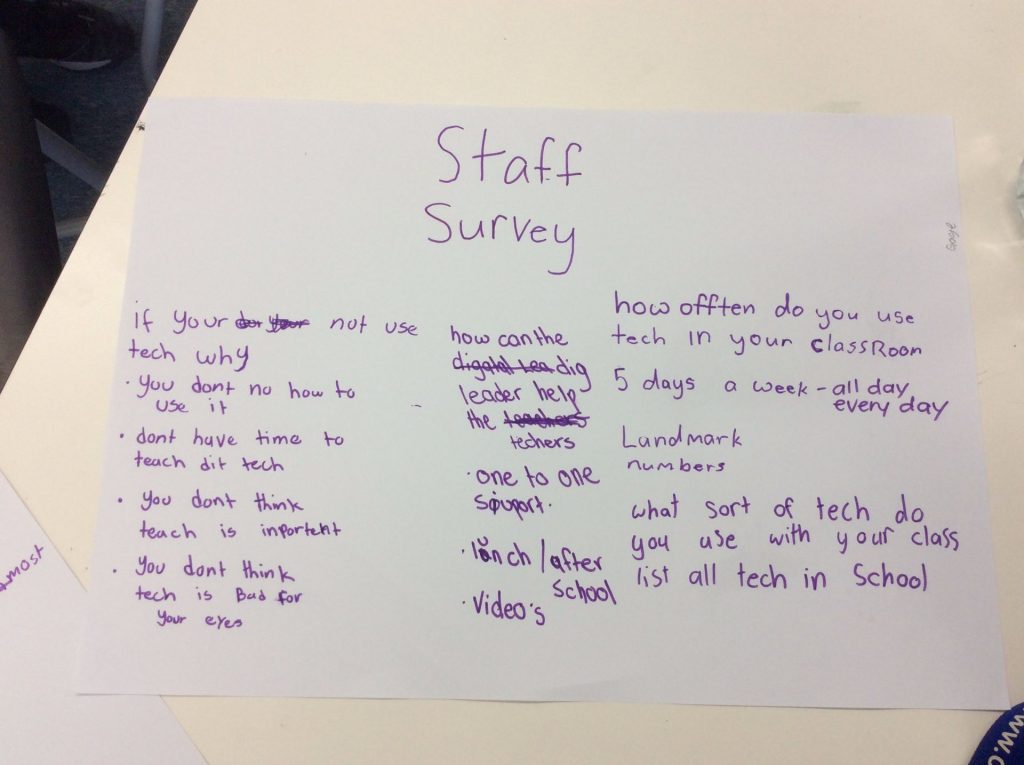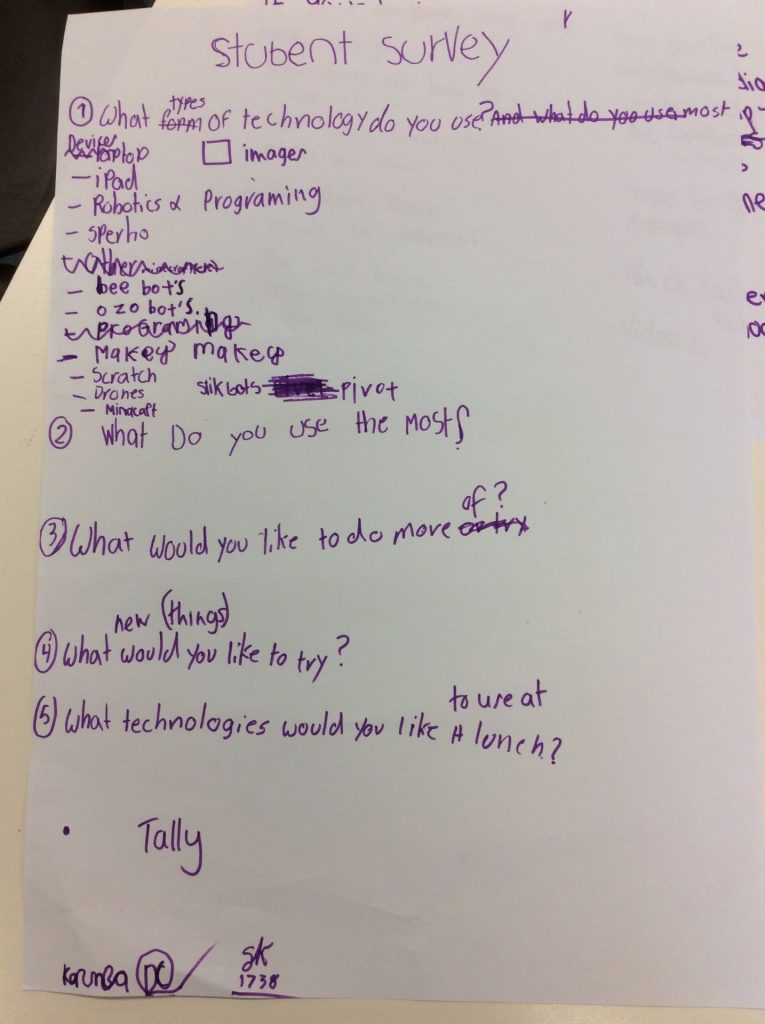Earlier this term, I rebooted our Student Digital Leaders program as part of my involvement in the Education Changemakers Aspiring Leaders program. The idea was to develop a partnership-wide program that involved students mentoring teachers on how to use technology and how to use it authentically to support student learning. Students would collaborate across sites to develop resources and to learn from one another. Through this approach, I was aiming to build students’ leadership capacity in terms of technology and to build teacher capacity in using technologies across the curriculum. Why focus on this? Digital Technologies is a relatively new curriculum area and teachers report that they lack confidence in this area, as well as in integrating technologies in other learning areas. Furthermore, in my experience, kids are more engaged when technologies are incorporated. I focused on using students to provide support to teachers as I am passionate about teachers learning with and from students and students are arguably the most knowledgeable users of technology.
The Context
At my current site, we have a lot of technology available to us and whilst there are pockets of staff using it, it’s not being used to its full potential. There was already a Digital Leaders program in place, which involved approximately 40-60 Years 5-7 students who completed projects of their choice (e.g. building an amusement park in Minecraft).They participated in 1 x 90 minute session per week. With the exception of a few Digital Leaders (who supported our Primary Special Class with Minecraft), there was no transference of their skills across the school.
The Process
After the last EC workshop, I researched various models of Student Technology Leaders and I came across Generation YES. It was a course that students could work through and was linked to the curriculum (albeit a US curriculum). I pitched my vision and framework to our Leadership team and invited feedback from them on how to sell the program to teachers. Their recommendation was to link the program to the Australian Curriculum (AC), assess students’ work and report back to their teachers.
I incorporated this into my pitch to the Digital Leaders’ teachers based on my knowledge of how they influence each other. This pitch was to get buy in, as in the previous term, I had overheard comments from teachers, such as “I don’t see the value in this program across the school” and “It interrupts Maths time”. I had reflected on their concerns and addressed these by re-positioning the program as part of core learning – students’ projects were cross-curricula, incorporating Maths, and all of their work would be assessed in line with the AC – and this enabled me to overcome initial resistance.
I had already pitched by idea to students in Term 2; however, there was little interest in the changes that I wanted to make. I gave up and continued with the previous Digital Leaders program.I re-promoted the concept at the beginning of Term 3 and re-invited students to participate. This time, there were clear expectations about how the program would be run and students’ responsibilities if they chose to participate. They all continued to attend our Digital Leader sessions.
Digital Leader sessions changed from two large groups to four smaller groups. This enabled me to provide more support and feedback to students. The sessions were comprised of 45 minutes to focus on their own project and 45 minutes to complete the leadership component. Their projects were linked to the AC and the GenYES program was modified to the reflect the AC.
One way in which student voice was incorporated was through the development of a staff survey. Students posed questions in order to capture baseline data (which helped me to collect data from teachers in a non-threatening way). This survey collected process data and provided a needs analysis. The results enabled us to target professional learning to meet the individual needs of staff.
Students have now started completed TAPs (Teacher Assistance Projects), which provides them with real life applications of their technologies skills. These TAPs have included simple tasks, like closing all of the open apps on iPads and deleting old photos (which has addressed some technical needs of staff), to more advanced tasks, such as creating a video tutorial for how to use and program MaKey MaKeys with Scratch. Knowing that they are teaching teachers has empowered students.
What’s the Impact?
My aim was to:
- increase teachers’ digital technologies skills and confidence in planning units of work incorporating digital technologies
- increase student achievement in the ICT General Capability and Digital Technologies curriculum areas
- increase students’ leadership skills in digital technologies
Looking back now, I feel that these are big aims for a short period of time. However, the impact that this program has had does begin to address my original aims:
- teachers have expressed interest in learning from Digital Leaders and using them in their classes to support them and their students
- teachers identified individual professional learning needs
- a revitalised Digital Leaders program, which has more rigour and is aligned to the AC, has been introduced and students have started completing modules of learning
- increased number of students enjoying the leadership component
- our first video tutorial for teachers – How to Use and Program MaKey MaKeys and Scratch
- three completed TAPs and more in progress
The Challenges
My biggest challenge was, and still is, changing the perception of what Digital Leaders is to students. For the majority, Digital Leaders has been a time for them to play Minecraft. Even last week, one ex-Digital Leader reminded me that we used to have Minecraft lessons and asked when they would be back. I feel as though I could have made more progress had there not been the expectation that students were able to ‘play’ when they came to Digital Leaders. When I first set the projects this term, mapped with curriculum links, and shared them with students, they looked at me like I was crazy. One group in particular, whose project was to recreate the school in Minecraft by measuring buildings (length, area, angles), were not interested at all in stepping away from the computer to go outside and measure the perimeter. I’m unsure whether this is due to me starting this part way through the year when student perceptions were already set or whether it’s because I haven’t communicated to students clearly enough.
My other main challenge is the size of the group. We have approximately 40 Digital Leaders altogether, who meet with me on different days – one group is small, the others are still too large. In order to ‘get stuff done’, I would look to make the team smaller. Working with a core team of 10 students would enable us to make more progress in the long run as I would be able to provide more intensive support and feedback. Students require significant scaffolding in the initial phase; once this first group are confident, I would re-promote to students.
The Next Steps
I believe there is significant value in this program, and as such, it is something that I’ll continue working on. There are still a lot of refinements that need to be made, so there will be ongoing reviews and tweaks to get it to a point where it’s making the most impact. Next year, I will be starting at a new site in a Coordinator role, and I’ll start the program there with modifications to address the challenges that I have faced this year.

 Originally, I had planned that even weeks would be when students focused on the leadership aspect and odd weeks would be when they completed their own projects to develop their tech skills. However, we were 45 minutes into the session today when we had finished developing the survey questions and I could see their interest was waning. As a result, the structure will change to each session having a 45 minute leadership component and a 45 minute project session.
Originally, I had planned that even weeks would be when students focused on the leadership aspect and odd weeks would be when they completed their own projects to develop their tech skills. However, we were 45 minutes into the session today when we had finished developing the survey questions and I could see their interest was waning. As a result, the structure will change to each session having a 45 minute leadership component and a 45 minute project session.
